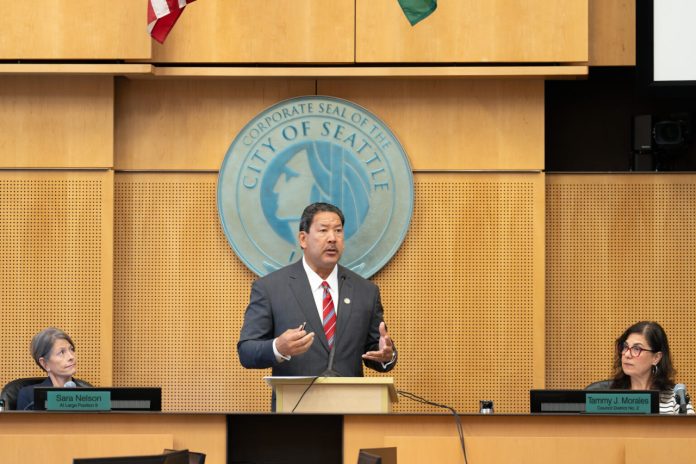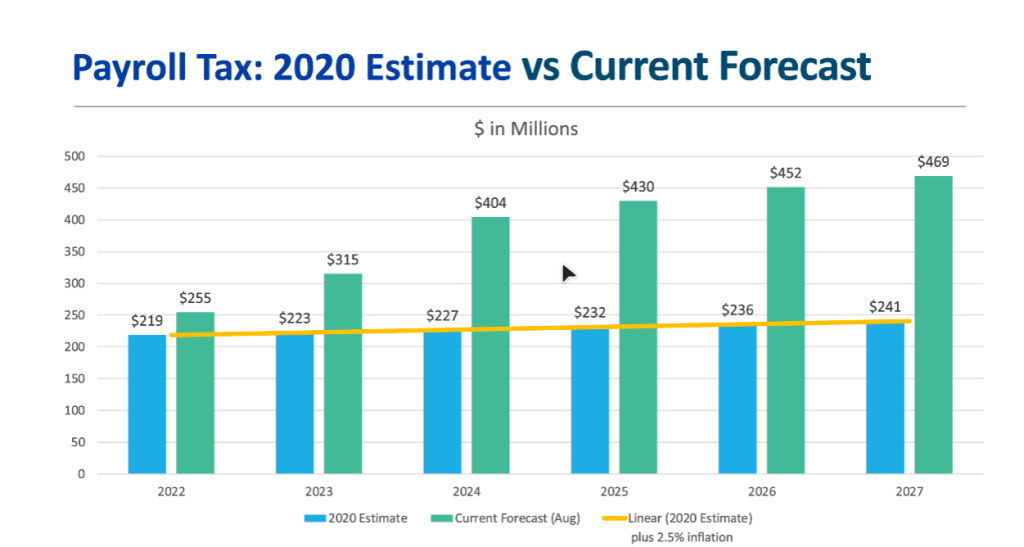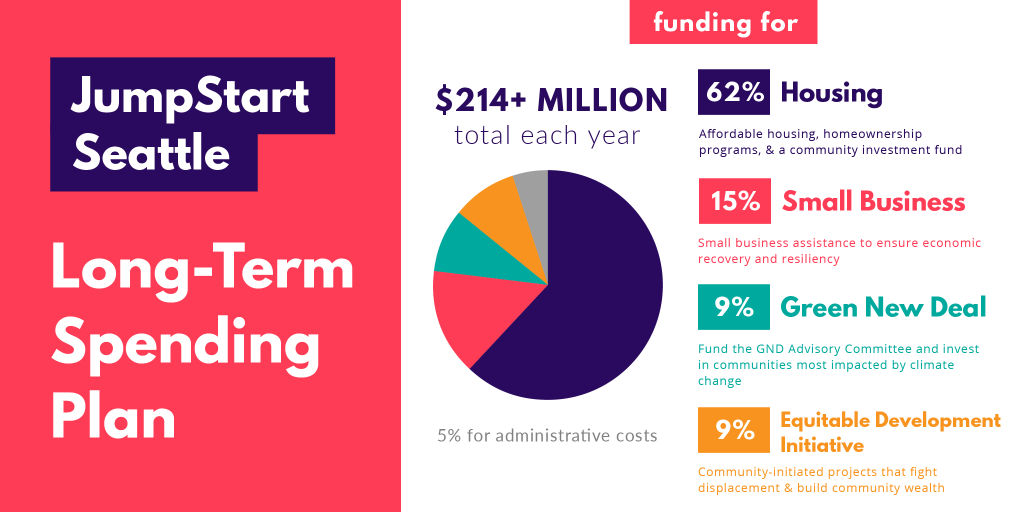
Budget cuts would mean layoffs at SDCI, HR, and IT, but broader reductions have mostly been avoided.
The 2025-2026 budget proposed by Mayor Bruce Harrell Tuesday avoids making major cuts to city programs and services by permanently diverting JumpStart payroll tax revenue into the general fund. Those higher-than-expected JumpStart funds, which had originally been intended to fund affordable housing, economic development, and Green New Deal investments, would be used to fill the majority of a $251 million deficit next year. That deficit is only expected to grow in future years.
Under the mayor’s plan, $287 million in formerly restricted funding would instead bolster the general fund, which actually includes an array of new spending priorities, many of them framed as public safety investments. In 2026, the raid on JumpStart would continue to the tune of $233 million.
The Seattle Police Department (SPD) and the Unified Care Team, which conducts homelessness encampment sweeps, are among the few growing parts of the proposed budget. SPD’s budget would increase $62 million to $457 million, composing 26% of the entire $1.9 billion general fund.
An additional $43 million in JumpStart funds would be set aside as a reserve to guard against the risk of a drop in revenue from the payroll tax, which is levied on businesses that generate at least $8.8 million in annual revenue, as of 2024. The tax hits only salaries higher than $182,000 at a tax rate (paid by the employer) ranging from 0.75% to 2.5% — only companies with annual payrolls exceeding $1 billion, such as Amazon, pay the higher rate.
Seattle has collected the JumpStart payroll tax since 2021, but Harrell officials portrayed projecting revenues as an inexact science, saying budget forecasters have turned to the performance of the stocks of a handful of leading tech companies to make predictions. Estimates for future JumpStart tax collections vary widely, with a recession holding the potential to drive revenue down.
When Councilmember Teresa Mosqueda shepherded the JumpStart program to passage in 2020, the tax was expected to bring in $232 million by 2025, using a linear inflation model on their initial best guess on revenue figures. However, the City now predicts it will pull in $430 million in 2025. The earlier conservative estimate seemed to factor in the uncertainty of levying a new tax and the criticism that taxing jobs would push high wage jobs to the suburbs.
That largely has not come to pass, with Seattle continuing to add high-paying jobs and see higher wages, even with some large tech companies like Amazon also expanding their presence in Bellevue and other suburbs. In fact, the City’s latest estimate puts JumpStart collections at $404 million in 2024 and $430 million in 2025, building off the $315 million collected in 2023.

The strong performance of JumpStart revenue is how Harrell was able to avoid systemic cuts in areas, like libraries, community centers, and homeless shelter beds, according to a briefing from Dan Eder, the interim Director at the City Budget Office. But even as the budget proposes new funding across multiple sectors, including for emphasis patrols by the Seattle Police Department, downtown public space activation, and an expanded encampment sweep team, it also includes the elimination of 159 city positions, including 76 positions that are currently filled.
The Seattle Department of Construction and Inspections (SDCI) would be particularly hard-hit by those reductions, with 9 full-time positions eliminated and another 20 sunsetted an entire year earlier than proposed. In defending the layoffs, which would include a number of positions that are already vacant, the City cited “declining permitting activity” even as a number of initiatives intended to spur housing production, including a new design review exemption for Downtown, are set to take effect. Additionally, the prospect of lower federal interest rates appears poised to spur construction and make more projects feasible.
The other staff reductions would be seen in departments that generally do not face the public, including the City’s Human Resources and Information Technology teams.
The budget also includes an approximately $2 million cut in funding for Seattle Channel, the public-access TV station that exists to shine a light on city government. As the Harrell Administration moves to add CCTV cameras to neighborhoods around Seattle as part of its crime reduction strategy, there are likely to be fewer cameras at City Hall in 2025.
In delivering the budget to the Seattle City Council, Harrell framed the proposal as essentially the best that the city could hope to deliver without structural reforms to Washington’s tax code.
“We don’t have the luxury of a pie-in-the-sky reimagining of our budget based on a hope that our State’s regressive tax system will magically change, or that Olympia would listen to the appeals of cities and counties large and small across Washington and lift the restrictive cap on local revenue,” Harrell said. “We made a conscious decision not to make broad cuts to essential General Fund programs like police, fire, and homelessness response.”
But another conscious decision was to not pursue additional revenue, despite the formation of a revenue stabilization workgroup in 2022 to deal with the looming budget gap that produced a number of potential options, including a city-level capital gains tax and a vacancy tax. Now the city budget seems poised to set a precedent that the dedicated payroll tax, passed as a commitment to affordable housing and Green New Deal investments, is not actually a dedicated fund.

While Harrell Administration has suggested the city council that passed JumpStart had no plan for spending revenue that came in beyond initial projections, that is not true. In fact, Council unanimously passed a spending plan, reinforced by Mosqueda’s guardrail legislation, that pledged 71% of payroll revenue would be invested in affordable housing, including the 9% set aside for the Equitable Development Initiative, which current councilmembers have criticized as poorly managed. Small business supports and Green New Deal investments made up the remainder of the spending plan, which was intended to work off of percentages rather than fixed amounts.
The Seattle Metropolitan Chamber of Commerce, which unsuccessfully sued to block the JumpStart payroll tax, heralded Harrell’s JumpStart-reliant budget plan for focusing on recruiting police and first responders while not raising taxes. Chamber President and CEO Rachel Smith contended that Seattle voters, who have passed every tax increase put before them in the last decade, are aligned with Harrell and the business leaders in not wanting to raise taxes to solve budget gaps.
“Mayor Bruce Harrell’s proposed budget invests in priorities that align with what voters want – it delivers on public safety, supports downtown revitalization, recruits more first responders, continues to support the CARE team and prepares the city to host the FIFA World Cup 2026,” Smith said in a statement. “It is a clear demonstration that when we align resources and priorities, we can deliver for our community. Voters have consistently said the city should balance the budget without raising taxes, and the Mayor’s proposal honors that while still making historic investments in housing and preserving shelter beds for people experiencing homelessness.”
“Historic” affordable housing investments
In defending the diversion of hundreds of millions in annual funding that had been reserved for housing investments and other long-term city priorities like its climate goals, the Harrell Administration pointed to the fact that they are leaving planned spending for those categories at their current levels, and only diverting additional revenue that the City (in 2020) did not expect to receive.
Thanks in large part to the newly renewed and expanded Seattle Housing Levy, the City will spend $339 million on affordable housing via the Office of Housing next year.
“The City has never spent as much money on affordable housing as we will spend in the mayor’s proposed budget for ’25 and it goes up yet again in ’26,” Eder told reporters Tuesday morning.

That said, when initially passed, the City pledged both JumpStart and the housing levy would to be additive above current spending levels, rather than JumpStart plugging a general fund budget hole and the housing levy plugging the hole left in JumpStart. Housing experts have warned that due to climbing construction costs and growing operational costs, affordable housing dollars will not stretch as far as they used to.
A coalition of 35 groups in the housing, labor, and community advocacy sectors, including the Housing Development Consortium, MLK County Labor Council, and Seattle Human Services Coalition, issued a statement in opposition to the mayor’s “stopgap” approach of cutting programs and raiding JumpStart housing funds to patch budget holes. (The Urbanist’s advocacy committee signed on to the letter, but the newsroom was not a part of that decision.)
“This structural shortfall requires a structural solution, not stopgap measures that will simply kick the problem another year down the road,” they wrote. “Responsible leadership means working to secure and deploy the revenue necessary to make our city healthy, safe, housed, working, thriving, and green. Seattle needs and deserves new progressive revenue to help meet our city’s commitments as soon as possible. Balancing the budget through cuts to vital city programs and services is not acceptable.”
New priorities: emphasis patrols, encampment sweeps, downtown vibrancy
In holding affordable housing and Green New Deal spending steady, and making cuts elsewhere, the Harrell Administration has been able to free up funding for its own priorities during a very tough budget year. Many of those priorities are framed as public safety investments, including an expansion of the city’s Unified Care Team (UCT), which exists to clear encampments around Seattle. The UCT will be expanded to cover Saturdays and Sundays to areas of the city that are considered encampment “hot spots.”
SPD expansions include $10 million in overtime for emphasis patrols, and new civilian positions including 21 employees in the City’s new Real Time Crime Center, and 14 new support staff in the areas of homicide, robbery, sexual assault, and gun crimes. Harrell proposes $2.8 million to support the City’s new contract with the SCORE jail in Des Moines.
While most departments face hiring freezes and several shed staff, SPD is actually funded for nearly 1,900 positions, many more that the agency can realistically fill over the next year — given a national shortage of police officers and agency recruiting challenges. In recent years, money set aside for those “ghost cop” positions has been used as a departmental slush fund, later directed to other safety investments, whether policing technology, additional overtime, or retention and hiring bonuses, which would jump from $30,000 to $50,000 under the plan.
There are also new funds for the Mayor’s Downtown Activation Plan (DAP), including public space activation, unspecified improvements at Westlake Park, and a “centralized DAP communications strategy.” Many of the larger elements of the DAP, including long-term improvements to Third Avenue, depend on additional revenues even beyond this, including funding that has been earmarked in the planned transportation levy renewal on voter’s ballots in November.

Harrell’s slightly boosted tree investments via $680,000 in new funding that would be used to create a new city tree nursery overseen by Seattle Public Utilities, which Eder described as potentially bringing a long-term savings benefit for the city while improving the health of Seattle’s tree canopy.
“It brings in house some work that we have been contracting with private entities for, to bring in ship in trees from other states, notably Oregon, and we think that we will have a better survival rate of the street trees — that’s what this is principally about,” Eder said. “We give away street trees; if we use native species that are grown here, and we can do that cheaper than buying them on the open market.”
With most members of the Seattle City Council making it clear that they’re also not on board with raising new revenue, it’s safe to assume that the overall contours of the budget won’t change dramatically by the time it’s approved in mid-November. In the first budget committee meeting since receiving the Mayor’s budget Wednesday, committee chair Dan Strauss said he was “glad and relieved” that cuts to services were not deep, and noted that the council had already set a precedent for utilizing JumpStart revenue to backfill the general fund.
“Every single year since JumpStart has been in effect, we have used JumpStart funding to backfill the general fund. This is not a new consideration this year,” Strauss said.
Nonetheless, what the Mayor is proposing is a permanent “structural change” to how JumpStart revenue is used at the City, funding an individual administration’s priorities ahead of the long-term needs around affordable housing and climate change. If the City Council signs off, that will represent a new idea, with long-term consequences.
This article has been updated to clarify the number of positions set to be eliminated at the Seattle Department of Construction and Inspections under Harrell’s budget proposal.
Ryan Packer has been writing for The Urbanist since 2015, and currently reports full-time as Contributing Editor. Their beats are transportation, land use, public space, traffic safety, and obscure community meetings. Packer has also reported for other regional outlets including BikePortland, Seattle Met, and PubliCola. They live in the Capitol Hill neighborhood of Seattle.



